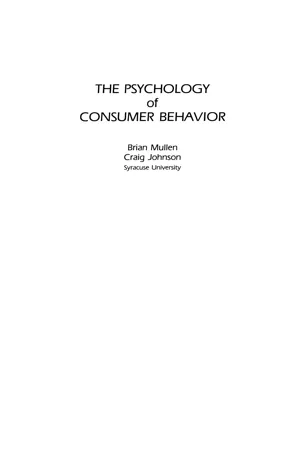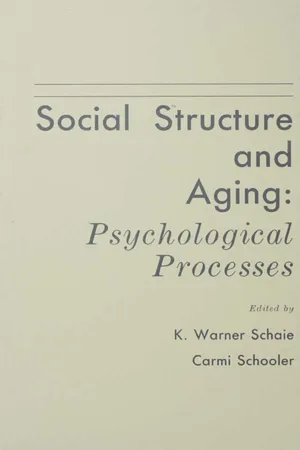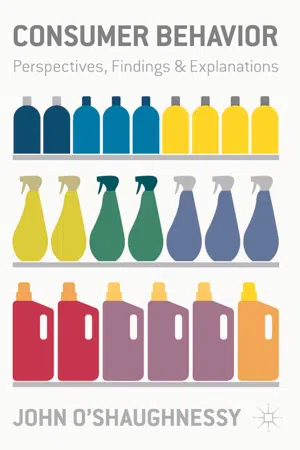Psychology
Social Effects
Social effects refer to the impact that interactions with others have on an individual's thoughts, feelings, and behaviors. These effects can include changes in attitudes, beliefs, and emotional states as a result of social influence, conformity, and group dynamics. Social effects are a key focus in understanding how individuals are influenced by their social environment and the people around them.
Written by Perlego with AI-assistance
Related key terms
8 Key excerpts on "Social Effects"
- eBook - ePub
- Brian Mullen, Craig Johnson(Authors)
- 2013(Publication Date)
- Psychology Press(Publisher)
10 The Social ContextT he social context refers to the totality of social stimulation that is influencing the individual. This can include the real, imagined, or implied presence of others (e.g., Baron & Byrne, 1987). The social context may be composed of friends, family members, and sales personnel (although discussion of sales personnel is postponed until chapter 12 ). The social context may also be populated by more indirect, symbolic others, including prominent figures, cultural heroes, and cartoon characters.The general model of consumer behavior presented in Fig. 1.1 portrays the stimulus situation, the internal processes, intention, behavior, and all of their interactions as being immersed in this social context. The effect of the social context on all of the previously discussed facets of consumer behavior is examined in this chapter. To begin, we consider the effects of the social context on perception, cognition, learning, emotion, motivation, intention, and behavior. Next, we consider a few individual differences that have relevance to social influences. Although these individual differences could just as easily have been considered in the treatment of psychographics in chapter 8 , we pay close attention in this chapter to individual differences that seem to moderate the effects of the social context on the consumer. Finally, we consider the effects of two distinct sources of social influence: opinion leaders and family members. Bear in mind that our task in this chapter is to understand how the social context influences consumer behavior.EFFECTS OF THE SOCIAL CONTEXT PerceptionThe classic illustration of the effect of the social context on perception is found in the study by Sherif (1935). This study took advantage of a perceptual phenomenon known as the autokinetic effect, that is the tendency for a motionless point of light in an otherwise dark room to appear to move. Sherif had subjects report on the extent of this (apparent) movement either alone or in groups. Subjects performing this task in groups tended to converge toward some commonly perceived range of movement that was unique to each group. These group-generated perceptions would endure beyond the presence of the group. That is, subjects tested individually afterwards maintained these group-established perceptions. This indicated that the social context actually affected perception, and not just some superficial behavioral compliance. - eBook - ePub
The Sciences Of Man In The Making
AN ORIENTATION BOOK
- Edwin A. Kirkpatrick(Author)
- 2013(Publication Date)
- Routledge(Publisher)
HAPTER XBEHAVIOUR IN RELATION TO OTHERS, OR SOCIAL PSYCHOLOGY
THE NEED FOR A SOCIAL PSYCHOLOGY
THE concept of general psychology is of an organism reacting to the physical environment, and improving in doing so by practice. Individual psychology not only recognizes differences in human organisms but emphasizes the truth that, in reacting in his special way, each individual builds a self whose parts are so organized that what is done in response to a situation is not wholly determined by either the situation or the sense and motor apparatus responding, but by the personality of the actor. Social psychology shows that there is also a social determiner of conduct. It no longer assumes a general “ social mind ” of which each individual mind is a part, but emphasizes the truth that the individual is directed and moulded by companions and by the customs and institutions of the group of which he is a part. These influences are shown to have more to do with determining behaviour than bodily structure or physical environment. Realization of the importance of personal and cultural influences in human behaviour has led to the present deep interest in social psychology, which is concerned with these interrelations.THE EFFECTS OF THE BEHAVIOUR OF ONE UPON ANOTHER
A hungry individual animal or man, when food is perceived, responds to the situation in a positive and active way. Another individual, also hungry, observes the response perhaps before he has observed the food, and is then influenced by the two stimuli to more vigorous action than the first one, who had the food stimulus only. As the second approaches and begins taking food, both become more active in getting it than would be the case if each was alone, especially if the amount is limited. If one interferes with the other’s attempt to get a portion the natural reaction is one of anger, which usually calls forth a similar response with further interference of each with the other, and increase in vigour of struggle. For a time, perhaps, the food is neglected while each tries to match the aggressive behaviour of the other by more effective responses of a similar kind. - eBook - ePub
Social Influence
Direct and Indirect Processes
- Joseph P. Forgas, Kipling D. Williams(Authors)
- 2016(Publication Date)
- Psychology Press(Publisher)
Within the social influence field, this shift towards social cognition has been reflected in a growing interest in persuasive communication phenomena, and in particular, research on the influence of different information processing strategies on how individuals respond to persuasive messages (Petty & Cacioppo, 1986). Clearly both approaches are necessary if we are to understand social influence processes. However, perhaps the time has come when we should look toward a greater integration between impactful, behavioral research, and cognitive and motivational approaches. As several contributors to this volume argue, social influence research has been handicapped by a rather restrictive conceptualization of what influence entails. We now know that social influence often works not because people are exposed to explicit pressures, but because they are encouraged to imagine events (Cialdini, this volume), experience particular moods (Forgas, this volume), are subconsciously influenced by incidental observations (see chapters by Dijksterhuis and by Petty, this volume), or engage in spontaneous group interactions (Latané & Bourgeois, Stangor & Jost, Sechrist & Jost, Terry & Hogg, David & Turner, this volume). In other words, in addition to highly familiar direct and face-to-face influence phenomena, influence also operates at cognitive, group, social, and cultural levels.Mass societies function well because they have developed efficient ways of influencing and coordinating the behavior of 'strangers' in ways of which we are barely aware. We are constantly bombarded with influence messages designed by a new class of 'social influence professionals' (see chapter by Cialdini, this volume), and we certainly need to understand better how these often invisible influence processes operate (see chapters by Schaller, Dijksterhuis, Petty, Ng, Terry & Hogg, David & Turner).We also want to argue in this volume that the traditional juxtaposition of the 'behavioral' and the 'cognitive' aspects of social influence is neither helpful nor necessary. A meaningful explanation of social influence phenomena must be based on an integrated analysis of the thoughts and motivations of individual social influence agents and recipients (see, for example, chapters by Cialdini, Knowles, Butler, & Linn, Forgas, Ng, this volume). On the other hand, social influence always occurs in real social settings, and we must pay careful attention to the personal relationships, group memberships, and cultural expectations that provide the pragmatic context for all influence processes (see Terry & Hogg, David & Turner, Spears, Postmes, Lea, & Watt, this volume). In a way, the dichotomy between cognitive and behavioral, and indirect and direct influence processes reflects one of the oldest debates in the history of psychology. Should psychology be primarily the study of 'mind,' or the study of 'behavior' (Hilgard, 1980)?We believe that understanding social influence processes, by definition, requires paying as much attention to the thoughts, motivations, and feelings of social actors—the 'mental world'—(Bless & Forgas, 2000) as to actual interpersonal behaviors. Thus, the proper focus of influence research should be the analysis of the interaction between the mental (cognitive) and the behavioral aspects of social influence processes. We referred to 'direct' and 'indirect' processes in the title of this book intentionally, to signify the close interdependence between the mental (cognitive) and the behavioral, interpersonal aspects of social influence. - eBook - ePub
- Vivien Burr(Author)
- 2005(Publication Date)
- Psychology Press(Publisher)
Chapter 6 The person in social psychologyWhere’s the ‘social’ in social psychology?
IN THIS BOOK I HAVE DISCUSSED a variety of perspectives and theories that may be referred to as social psychology and, in each case, I have asked what it is about them that is social. The answers to this question are also very varied, and have important implications for what can be said about the central concern of the book and of this final chapter – the nature of the person in social psychology. For the purposes of drawing out the relevant themes I have chosen to contrast the current individualistic and intrapsychic approach of social cognition with a variety of others that may be thought of as interpersonal, societal or a mixture of both.The intrapsychic model: social cognition
It may be argued that the predominant psychological social psychology with which psychologists are familiar has become increasingly individualistic and intrapsychic in orientation in recent times. In the past it has often been concerned to identify the impact of the presence or conduct of other people upon the functioning and behaviour of individuals, for example in the social facilitation experiments of Triplett (1898) which are regularly quoted as being among the very first experiments in social psychology. Much research on phenomena such as obedience, conformity, bystander behaviour, group decision-making and interpersonal attraction can be thought of as fitting this picture. The social here is conceived as a set of variables relating to other people and their conduct that may influence a pre-existing, self-contained individual. Other research and theory, particularly that which focuses upon dynamics within and between groups, has sometimes gone beyond this position to suggest that a person’s location within social groups is an important source of identity and self-esteem. The role of the social here is not simply one of impacting upon a pre-existing individual but in some way helping to create - Dogan Gursoy, Sedat Çelik, Dogan Gursoy, Sedat Çelik(Authors)
- 2022(Publication Date)
- Routledge(Publisher)
However, it was not until the 1900s that social psychology began to develop as a branch of science (Güney, 2009, p. 1). In this process, social psychology, a newly developing branch of science, has been examining people’s social behavior by using the concepts and approaches of both sociology and psychology (Tutar, 2013, p. 43). Sociology focuses on social factors, and psychology focuses on individual factors; social psychology, on the other hand, examines the individual in the group, the effects of the group on the individual, and the group-individual interaction (Zencirkıran, 2017, p. 3). In other words, social psychology deals with the behavior of people who are influenced by their environment and other people, rather than just individual (field of psychology) or social (field of sociology) behaviors. Thus, social psychology was born out of the need to explain interactions, relationships, situations, and phenomena that sociology and psychology fail to explain (Güney, 2009, p. 3). Social psychology is the science of examining the behavior of an individual or individuals in a society (Kağıtçıbaşı, 2014, p. 22). In other words, social psychology is a discipline that scientifically examines people’s opinions about other people and the way they interact with them (Tutar, 2013, p. 45). In addition, social psychology is also expressed as a field of science that tries to understand the nature and causes of individual behavior in social environments (Gnoth, 2014). In this sense, social psychology examines the individual and his/her environment and the social groups consisting of the group and its environment (Küçün, 2019, p. 43). Tourism is a mind-opening experience that teaches people that the world does not consist of a single life model. There are other life models (Wintersteiner & Wohlmuther, 2014) because it is believed that tourism positively affects world peace- eBook - ePub
Foundations of Social Cognition
A Festschrift in Honor of Robert S. Wyer, Jr.
- Galen V. Bodenhausen, Alan J. Lambert, Galen V. Bodenhausen, Alan J. Lambert(Authors)
- 2004(Publication Date)
- Psychology Press(Publisher)
11The Effects of Power on Those who Possess It: How Social Structure can Affect Social Cognition
Deborah A. Greenspan Stanford University Dacher J. Keltner University of California, Berkeley Cameron Anderson Northwestern UniversityINTRODUCTION
Research on social cognition is typically concerned with how the minds of individuals perceive, encode, recall, and judge the behavior of social targets. Recently this literature has been touched by invigorated interest in the social and interpersonal contexts in which social cognitions occur (e.g., Levine, Resnick, & Higgins, 1993; Resnick, Levine, & Teasley, 1991; Thompson, Levine, & Messick, 1999). Building on classic work by Asch (1951), Festinger (1954), McGuire (1969), and Zajonc (1960; 1965), among others, psychologists who care about the social and sociological determinants of behavior have begun to investigate how social systems such as culture (Markus & Kitayama, 1991; Morris and Peng, 1994), demography (McGuire & Padawer-Singer, 1976, Steele & Aronson, 1995), democracy (Keltner & Robinson, 1996; Nemeth, 1986; Gruenfeld, 1995; Gruenfeld & Preston, 2000), hierarchy (Bargh, Raymond, Pryor, & Strack, 1995; Fiske, 1993; Jost & Banaji, 1994; Keltner, Gruenfeld, & Anderson, in press), accountability (Tetlock, 1992), and interpersonal relationships (Staudinger & Bakes, 1996; Wegner, Erber, & Raymond, 1991) affect basic cognitive processes.Bob Wyer was, as usual, a pioneer in this branch of social cognition research. After having what would easily count as a successful career developing a seminal and purely individual paradigm for the study of person memory, Wyer began to look outside the head and into the world of the social perceiver (Wyer, Lambert, Budesheim, & Gruenfeld, 1992). Wyer’s work on how social cognition is affected by conversations (Wyer, Budesheim, & Lambert, 1990; Wyer & Gruenfeld, 1995a; 1995b; Wyer, Swan, & Gruenfeld, 1995), communication norms (Gruenfeld & Wyer, 1992; Wyer, Budesheim, Lambert & Swan, 1994), political affiliations (Waenke & Wyer, 1996), and close relationships (Gaelick, Bodenhausen, & Wyer, 1985) illuminated and directed the field toward a number of important aspects of social context. - eBook - ePub
Social Structure and Aging
Psychological Processes
- K. Warner Schaie, Carmi Schooler, K. Warner Schaie, Carmi Schooler(Authors)
- 2013(Publication Date)
- Psychology Press(Publisher)
Social Structure Effects and Experimental Situations: 4 Mutual Lessons of Cognitive and Social Science Carmi Schooler, National Institute of Mental HealthThe central focus of this chapter is on how two important approaches to understanding the psychological aging process — the study of social structural effects on individual psychological functioning and the experimental investigation of the nature of cognitive functioning — can inform each other. Because my vantage point tends to be that of the social scientist, I can, of course, fairly easily discern the difficulties that social science findings pose for cognitive science. On the other hand, I am aware that, no matter how great these difficulties are, if social scientists are interested in how social structure affects what people think, they must come to grips with the central topic of cognitive research — how people think.In particular, if, following Marx (1964), Mannheim (1954), and Merton (1968), social scientists are concerned with how individuals’ vantage points in the social system affect their belief systems, then they must understand the psychological laws through which people generalize what they have learned in one context to another. On the other hand, as we see in this chapter, the findings of both social and cognitive research indicate that the very ways in which people think and quite possibly generalize are affected by their social structurally and culturally determined experiences. Such findings cast strong doubt on the view, apparently held by many cognitive researchers, that cognitive processes are essentially the same among all normal individuals. Because we cannot take such similarity for granted, it would seem wrong for us to generalize about cognitive functioning from the performance of whatever subjects come most readily to hand. - eBook - ePub
Consumer Behaviour
Perspectives, Findings and Explanations
- John O'Shaughnessy(Author)
- 2012(Publication Date)
- Bloomsbury Academic(Publisher)
Chapter 11 Social Psychology: Social Groups, Social Reference Groups and the Nature and Role of Emotion in Influencing Behavior SOCIAL PSYCHOLOGY’S FOCUS Social psychology investigates how individuals are influenced by interactions with others and by the actual or imagined presence of others. Much about the consumer’s life is social and social influences need to be considered for understanding buying behavior. When we think about things that concern us, other people usually form the background. One of the earliest theories in social psychology to be imputed to buyer behavior was cognitive dissonance (already discussed), developed in the 1950s by Leon Festinger. Festinger (1957) maintained that, when people are confident about their proposed action (such as buying), they believe the action to be: Desirable Rationally defensible Socially appropriate. If an action is desirable, rationally defensible and socially appropriate, the proposed buying action possesses subjective validity for the buyer. The need for the action to be socially appropriate is something not considered in economics but is basic in social psychology. However, it is not always clear that these criteria are employed whenever the consumer is confident she has made the right decision. Nonetheless, sellers who demonstrate to the satisfaction of the buyer that the purchase is desirable, rationally defensible and socially appropriate are likely to be persuasive. Hence sellers should set out to meet these criteria. When sellers meet expectations without postpurchase reservations, this translates into a post-purchase evaluation of the purchase as being desirable, rationally defensible and socially appropriate. The problem remains of uncovering the bases for subjective validity since we want to know what our target customers think is desirable, rationally defensible and socially appropriate – and what is not
Index pages curate the most relevant extracts from our library of academic textbooks. They’ve been created using an in-house natural language model (NLM), each adding context and meaning to key research topics.







